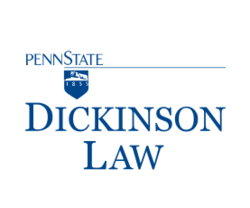Difference between revisions of "Dickinson School of Law"
(Added: type, website, motto.) |
(unstub) |
||
| (2 intermediate revisions by one other user not shown) | |||
| Line 3: | Line 3: | ||
|logo=Pennsylvania State University Dickinson Law Word Mark.svg | |logo=Pennsylvania State University Dickinson Law Word Mark.svg | ||
|constitutes=university | |constitutes=university | ||
| − | + | |start=1834 | |
| − | |start= | + | |headquarters=Carlisle, Pennsylvania. |
| − | |headquarters= | ||
|type=Public law school | |type=Public law school | ||
|website=https://dickinsonlaw.psu.edu/ | |website=https://dickinsonlaw.psu.edu/ | ||
|motto=Practice Greatness | |motto=Practice Greatness | ||
| − | }} | + | |description=One of two separately accredited law schools of The Pennsylvania State University. |
| + | }}''Not to be confused with [[Penn State Law]]'' | ||
| + | '''Penn State Dickinson Law''', formerly '''Dickinson School of Law''', is a [[Public university|public]] [[law school]] in [[Carlisle, Pennsylvania]]. It is one of two separately accredited law schools of [[The Pennsylvania State University]], the other being [[Penn State Law]]. | ||
| + | |||
| + | ==History== | ||
| + | The Law School offers J.D. and LL.M. degrees in law and hosts visiting scholars. The Law School was opened by Judge John Reed in 1834 as the law department of [[Dickinson College]], named for [[Founding Fathers of the United States|Founding Father]] [[John Dickinson (Pennsylvania and Delaware)|John Dickinson]].<ref>http://www.biography.com/people/john-dickinson-9274211</ref> It received an independent charter in 1890 and ended all affiliation with the college in 1917.<ref>http://www.dickinson.edu/info/20048/history_of_the_college/1404/the_dickinson_story</ref> | ||
| + | |||
| + | In 2000, Penn State and The Dickinson School of Law completed a merger that began in 1997. From 2006 until 2014, Penn State’s Dickinson School of Law operated as a single law school with two campuses – one in [[Carlisle, Pennsylvania]] and one in University Park, Pennsylvania. In the summer of 2014, Penn State received approval from the ABA to operate the two campuses as two distinct law schools (now known as [[Pennsylvania State University - Penn State Law|Penn State Law]] and Dickinson Law), both of which share the history and achievement of The Dickinson School of Law. | ||
{{SMWDocs}} | {{SMWDocs}} | ||
==References== | ==References== | ||
{{reflist}} | {{reflist}} | ||
| − | |||
Latest revision as of 04:02, 9 July 2022
(University) | |
|---|---|
 | |
| Motto | Practice Greatness |
| Formation | 1834 |
| Parent organization | Pennsylvania State University |
| Headquarters | Carlisle, Pennsylvania. |
| Type | Public law school |
| One of two separately accredited law schools of The Pennsylvania State University. | |
Not to be confused with Penn State Law
Penn State Dickinson Law, formerly Dickinson School of Law, is a public law school in Carlisle, Pennsylvania. It is one of two separately accredited law schools of The Pennsylvania State University, the other being Penn State Law.
History
The Law School offers J.D. and LL.M. degrees in law and hosts visiting scholars. The Law School was opened by Judge John Reed in 1834 as the law department of Dickinson College, named for Founding Father John Dickinson.[1] It received an independent charter in 1890 and ended all affiliation with the college in 1917.[2]
In 2000, Penn State and The Dickinson School of Law completed a merger that began in 1997. From 2006 until 2014, Penn State’s Dickinson School of Law operated as a single law school with two campuses – one in Carlisle, Pennsylvania and one in University Park, Pennsylvania. In the summer of 2014, Penn State received approval from the ABA to operate the two campuses as two distinct law schools (now known as Penn State Law and Dickinson Law), both of which share the history and achievement of The Dickinson School of Law.
Alumni on Wikispooks
| Person | Born |
|---|---|
| Tom Ridge | 26 August 1945 |
| Rick Santorum | 10 May 1958 |